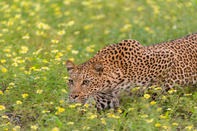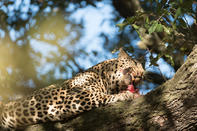Master Stalkers
Leopards are master stalkers and they will painstakingly approach to within ten or even five meters of their quarry before launching an attack.

They rely on the element of surprise and their powerful bodies to capture prey which is grappled with the foreclaws and then bitten on the back of the head or around the throat. Leopards are the ultimate opportunists. Although they are essentially nocturnal animals, they will not ignore hunting opportunities that present themselves during the day time.
They will generally eat small to medium-sized antelope (up to 70 kg in weight) like impala and duiker but depending on circumstances will make use of 92 different food sources including unusual items such as winged termites, stranded fish, ground birds, rodents, reptiles, porcupine, aardvark, tree squirrels, rock hyrax, mongoose, genet and even baby buffalo.
They are not usually big scavengers but are prone to stealing kills from cheetah.
Fussy Eaters

Leopards are relatively fussy eaters (although they are not averse to putrid carrion) and will typically pluck the hair or feathers of their food before consuming it. The intestines of larger prey are discarded and subsequently covered up to mask the smell so that other scavengers like lion or hyena are not attracted to the kill site.
The remains of a carcass may also be covered up with vegetation or soil to keep it safe should the leopard need to dessert it temporarily. In areas where leopards are regularly harassed by lion or hyena, they will hoist their prey into a tree where these large and clumsy scavengers are less likely to access it.
Hyena will often wait beneath a tree in which a leopard is feeding to pick up the scraps dropped.
Sometimes large parts of the kill may come free and fall down to the opportunists below. Leopards feed on the ground in areas where there are few scavengers. Lions and hyena will rob inexperienced leopards of their kills, as will other leopards.
By Megan Emmett